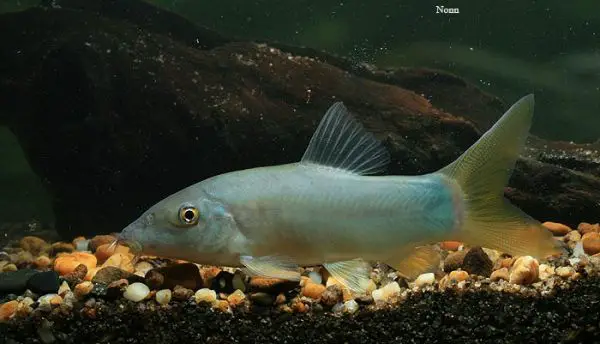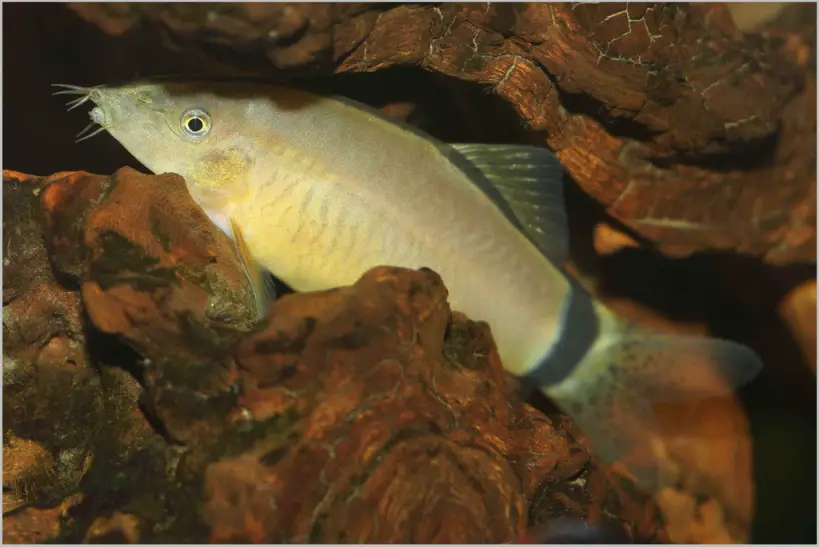Botiid fishes of the ‘Modesta complex’ – an analysis of natural history and behaviorisms
Mike Ophir
Long ignored as the maintenance crew of the community freshwater aquarium, the group of fishes commonly referred to as “Loaches” have clearly enjoyed increased popularity in the aquarium trade in recent decades. An increase in demand has resulted in an appreciation of the diversity of this loosely group assembly of species and yet, it appears as though knowledge for how to care for loaches in the home and public aquaria remains insufficient in order to maximize their health and beauty. From the perspective of evolutionary biology, loaches are a key example as to how natural selection selected the various families, genera and species that the average aquarist encounters today. Their appearances range from the elongated, eel-like shape of khuli loaches (Pangio), to the robust Clown loach (Chromobotia macracantha). Their shapes, body patterning and coloration, and behaviors have been selected for based on what type of environment these animals inhabit.
On the whole, loaches are social animals that require the company of their own kind, or at least genus. Isolation results in loneliness and a correlation with increased aggression towards tankmates, regardless of size or inherent disposition. Recapitulation of the endemic habitat from which a particular loach hails from is also key to maintaining healthy, long-lived animals that will provide countless years of joy if maintained properly. Hence, this article will attempt to cover some basic concepts required of all loach keepers to follow to the best of their abilities. One of the most commonly available types of loach in the aquarium trade are those of the family Botiidae.

The Suriya River in Thailand, habitat of Botia kubotai. Botiid loaches do best when maintained in an aquarium designed to simulate their natural environment. © Nonn Panitvong
The family Botiidae comprises a large, diverse family of fish that encompass the genera Botia, Yasuhikotakia, Ambastaia, Chromobotia, Syncrossus, Leptobotia and Sinibotia amongst others. Some of the more common species available in the aquarium fish trade include the Clown loach (Chromobotia macracantha), while others have rarely been seen such as Yasuhikotakia. longidorsalis. Although much has been elucidated with regards to the natural history and husbandry of readily available Botiids, the behaviorisms and requirements for optimal care of other species remain poorly characterized. In particular, Botiid species of the ‘Modesta complex’ have been relatively ignored due to their larger size, assumed drab coloration and temperamental behavior.
In this article, I will explain how to properly identify Botiid species of the Modesta complex, their varied behaviors, fascinating color patterns, and how to properly care for them in home aquaria. An appreciation of their behavior and natural history would significantly increase the chances of proper aquarium care and would thus make them more widely available in the aquarium hobby. It is my firm belief that Modesta complex botiids can make great and valuable additions for a variety of aquaria.
An overview of the ‘Modesta complex’

Figure 1. The Modesta complex can be subdivided into 3 subgroups: modesta, eos, and morleti. © Mike Ophir
The Modesta complex encompasses its namesake, Yasuhikotakia modesta (Redtail loach), a large deep-bodied fish that at one point was as readily available in the trade as the Clown loach. Other species include Yasuhikotakia lecontei (Leconte’s loach), Yasuhikotakia morleti (Skunk loach), Yasuhikotakia caudipunctata (Speckle tailed loach), Yasuhikotakia splendida (Jaguar loach), Yasuhikotakia eos (Sun loach), and Y. longidorsalis. Common characteristics of this family include the presence of an arched back, a typically monochromatic body of either blue, grey, brown or cream coloration, and vertical bars that are most prominently evident near the base of the caudal fin, but can also be present in the dorsal, pectoral, and anal fins.
Behaviorally, all species in this group are somewhat territorial, with Y. eos, Y. morleti and Y. splendida being the most aggressive, and Y. caudipunctata and Y. modesta being fairly placid. It is also interesting to note that almost all Modesta botiids are most active during twilight and night, compared to other loaches such those of the ‘Indian complex’ (Botia spp.). Because of their territorial nature, Modesta complex botiids should be housed in aquaria with appropriate tankmates. Species with elongated or feathery fins are not ideal choices, as the loaches may nip and nibble on them to no end. Rather, large robust barbs or characins would be ideal dither fish. The importance of housing Modesta complex botiids with dither fish cannot be overstressed. Without the presence of dither fish to signify that the environment they live in is safe, the loaches will become skittish and more aggressive than they would be otherwise. Other tank mates of these fish should be fairly large and boisterous.
Be sure to keep any botiid fish in groups of no less than 4 even if they are territorial. They prefer the company of their own kind as juveniles and do not actually display aggression amongst themselves but only to other botiid species. Hence, docile species such as Botias and Ambastaia should ideally not be kept with Modesta complex fish. To minimize territorial squabbles, provide plenty of rockwork for the aquarium that will house Modesta complex botiids and take care to provide at least 2 hiding spots for every specimen that will be kept. The barbels of these fish provide sensory functions that help locate food and navigate in the darkness; as a result, it is important that the substrate consist of soft, round pebbles that could not in any way damage these barbels.
Why do Modesta Botiids produce clicking noises?
Far and away, species of the Modesta complex produce the greatest amount of clicking of all Botiids. This noise has been shown to stem from the grinding of pharyngeal teeth located in the throat of the fish. This clicking noise is heard frequently during feeding and territorial bouts, indicating that it may be a display mechanism to warn others in the group of its presence and dominance. In fact, studies have found that sound production in Y. morleti correlates with the physical condition of specimens studied (i.e. size and health) and that resolution of aggressive behavior is resolved by the production of loud clicks. Such noise production would be evolutionarily advantageous to prevent escalations in conflicts with larger and more threatening species.
However, clicking cannot be solely a function of physical condition as large botiid species such as Botia rostrata and Botia histrionica do not make loud clicking noises during feeding or confrontation in my experience. Furthermore, smaller species of the Modesta complex such as Y. morleti and Y. splendida tend to produce louder clicks than larger species such as Y. modesta and Y. caudipunctata; these are qualitative observations from home aquaria settings which require quantitative measurements and detailed study. Regardless, these observations beg the question: why and how has the Modesta complex developed such vocalization compared to other families of fish that inhabit overlapping locales along the Mekong river and other habitats throughout south-eastern Asia?
The answer may lie in the fact that compared to many other fish species in the Mekong basin, most Botiid loaches are small fish. Hence, to protect their territory and ensure their survival, they may use clicking as a mechanism to warn off potential intruders and predators. In comparison, species such as B. histrionica and B. kubotai are more commonly found in smaller bodies of water such as the Ataran river in Myanmar where the habitat and lifestyle of botiid fish may be significantly different and displays of aggression may not be as critical for survival; further work will be required to investigate behavioral differences between various botiid genera. Furthermore, clicking may serve as a way to display dominance during mating in order to court females. Larger and healthier specimens tend to produce louder clicking noises and hence may signify an attractive quality in a potential mate.
Distinguishing characteristics amongst species of the Modesta complex
In the following section, I will describe the physical characteristics of several botiids of the Modesta complex. Because species in this group of fish appear so similar to one another, it is important to elaborate on their morphology and patterning to ensure proper identification and as a result, adequate husbandry.
Yasuhikotakia modesta and Yasuhikotakia lecontei – Red/yellow-finned loaches
Compared to Leptobotia and Sinibotia, Modesta complex botiids have short bodies and high, arched backs. These common physical characteristics may make it difficult for the novice to distinguish between distinct species. Y. modesta typically has a blue-gray body with a triangular dorsal fin and a forked caudal fin. This fish can grow fairly large (up to 8 inches TL) so be sure to provide a large aquarium with plenty of swimming space. There are three main color variations of Y. modesta: red-finned, orange-finned, and yellow-finned. Although not certain, it is believed that these color variations are representative of independent populations of fish that are slightly divergent from one another. In fact, genetic analysis has demonstrated that these color morphs are genetically distinct populations. The red-finned variety is the most commonly available form in the aquarium trade, while yellow finned forms are seldom seen. Y. modesta is closely resembled by Y. lecontei which sports a grey body and yellow or orange fins. Unlike Y. modesta however, Y. lecontei has a more elongated body, similar to that of Botia species. This species can also grow to significant sizes and large aquaria are recommended to ensure optimal health and happiness of the fish.
Yasuhikotakia caudipunctata – Speckle-tailed loach
Another species that resembles Y. modesta and Y. lecontei is Y. caudipunctata (Speckle-tailed loach). This fish too has a greyish-blue body and a forked caudal fin. However, the single most defining trait of this species lies in its latin name (caudi – caudal fin; punctata – spotted). The caudal fin is typically colorless and clear, and is decorated with numerous small spots. The base of the caudal fin sports a vertical dark bar. This species has a temperament similar to that of Y. modesta but can often be more territorial. Growing to a maximum size of 7-8 inches TL, large aquaria are a prerequisite for keeping this fish in good health. There are variations in populations of Y. caudipunctata as well. Those that hail from the Mun river, a tributary of the Mekong, have spots adorning the dorsal fin in addition to the caudal fin. Furthermore, the Mun river variety typically has clear yellow fins. It is unclear whether the Mun river population is genetically distinct from others, but based on these morphological differences, it is likely that this is the case. Not widely available in the aquarium trade, Y. caudipunctata can typically be found as contaminants of shipments of Y. modesta and Y. lecontei so be on the lookout! With proper care, these fish can be fairly long lived and can survive on a diet of various flaked foods.
Yasuhikotakia splendida – Jaguar loach
Y. caudipunctata is not the only Modesta complex botiid to have dots on its caudal fin; Y. splendida, Y. longidorsalis and Y. morleti also have dotted caudal fins. Unlike Y. caudipunctata, which is found in both Thailand and Laos, Y. splendida is found exclusively in Laos and is a significantly smaller fish, reaching a total length of only 4.5 inches in adulthood. Unlike previously discussed Modesta complex botiids, the small size of Y. splendida makes it ideal for smaller aquaria. Found in overlapping river systems, Y. splendida can be distinguished from Y. caudipunctata in that the spots on the Y. splendida caudal fin are significantly larger and poorly defined – giving rise to a blotchy appearance like that of a jaguar (hence its common name of Jaguar loach). Furthermore, the caudal fin is electric yellow and the intensity of this coloration correlates with the dominance of the fish within a social hierarchy, with subordinate specimens appearing more drab. Furthermore, Y. splendida can be distinguished by the presence of a diagonal black strip found just below the tip of the dorsal fin. This stripe runs the length of the fin and is found in both juvenile and adult specimens. Y. splendida sports an olive-brown body and has thin, faint vertical bars that extend from behind the head of the fish, to the base of the caudal fin. At the base of the caudal fin lies a thick black crescent like band that extend up to half-an inch into the body of the fish, which is preceded by a thinner cream colored band. The pectoral and anal fins of this species are clear and lack any coloration or patterning. Y. splendida is perhaps the most social of Modesta complex botiids; they can be frequently observed shoaling throughout the aquarium or resting amongst rockwork and driftwood. Although they do display intra-species aggression, almost no aggressive behavior is exhibited to other tankmates. Because of their social nature and frequent diurnal activity it is important to keep these fish in groups of no less than 5.
I personally have observed what I would describe as breeding behavior amongst this species. Sexual dimorphism is evident as females are typically fatter and more brightly colored, whereas males are smaller, slimmer and slightly more drab in coloration. Gravid females will shimmy with small males throughout the aquarium for minutes at a time. This shimmying occurs repeatedly over the course of a few days and then ceases at which time the females look slimmer, which would indicate eggs have been laid, although I cannot verify this, as I have not personally seen eggs laid. However, the eggs may have been laid in caves or rockwork and subsequently gobbled up by other loaches in the aquarium. This is an extremely rare species and as a result, expensive. However its beauty is unparalleled in the Modesta complex and hence, I urge anyone able, to keep this species in an attempt to spawn them so as to reduce reliance on wild caught stocks.
Yasuhikotakia morleti – Skunk loach
Another smaller species of the Modesta complex is Y. morleti. This species can be distinguished from others has having a cream-brown colored body and a defining black stripe that runs from the snout to the base of the caudal fin, hence its common name of skunk loach. An aggressive species, this fish should be kept in large groups to diffuse potential aggression exhibited to other tankmates. Like Y. caudipunctata and Y. splendida, Y. morleti has small speckles on its caudal fin and so cannot be separated from the two preceding species on this basis alone. The anal and pelvic fins are a deep red in mature specimens, and the anal fins are adorned with a black band that outlines the entire fin. This species reaches a maximum length of 4 inches TL and hence can be kept in smaller aquaria. However, be sure to provide plenty of hiding places and soft substrate for the fish to burrow and root around in. Care and behavior is very similar to that of Y. splendida. It is also produces one of the loudest clicks amongst Modesta complex botiids. Like Y. splendida, sexual dimorphism is evident as females are typically plump and males skinny with less coloration. Juvenile specimens will often sport black vertical bands on their flanks that fade with age. The purpose of these black bands is unclear, but may be a biological mechanism to enable camoflauge of youngsters from predators in their native environments. Mature, healthy Y. morleti can be distinguished by bright red anal fins lined by a thick black bar that outlines the fin. This coloration is typically seen in males. Mature specimens of both sexes may also occasionally sport a yellow caudal fin. Such diverse coloration on one fish makes it an attractive species to keep in the home aquarium.
Yasuhikotakia eos – Sun loach
Y. eos is an aggressive, solitary fish. Even if bought in significant numbers, this fish will quickly separate from the group and stick to itself. Growing to a maximum size of 6 inches TL, Y. eos should be housed in a large aquarium devoid of plants, and provided with plenty of rockwork for hiding. It appears to be an almost strictly nocturnal species, venturing out of its hiding spots during the day only to feed or chase away intruding fish. It differs physically from other Modesta complex botiids by having an elongated, almost rectangular dorsal fin positioned further to the back, closer to the caudal fin. The pectoral, anal and caudal fins are typically red in coloration with some white stripes outlining these fins in adult specimens. The body is more elongate than that of Y. splendida and Y. morleti, similar to that of Y. lecontei. It has a prominent forehead and small eyes. It is commonly confused with Y. longidorsalis in aquarium literature, but Y. longidorsalis has never (to my knowledge) entered the aquarium trade. It is seldom seen in the aquarium trade due to its aggressive nature, nocturnal tendencies, and lack of intense coloration until its adult stages.
Many thanks to Mike, plus image contributors Nonn Panitvong, Kelly Unscharf and Mark Duffill.
Category: Articles, Freshwater Fishes | Tags: Botia, botiid, Chromobotia, loach, loaches, modesta, Yasuhikotakia | Comment »










Product reviewers wanted
Are you still looking for product reviewers?
19th Dec 2024
Product reviewers wanted
Hey! Interesting article!
17th Dec 2024
Site improvements
Got it! Thanks for the update. It's good to know that Seriously Fish is working on improving the site's performance and addressing the email and forum...
21st Nov 2024
Responsive design
Nice
13th Nov 2024
Responsive design
it is a complete malfunctioning horror on iphone and ipad.
10th Nov 2024